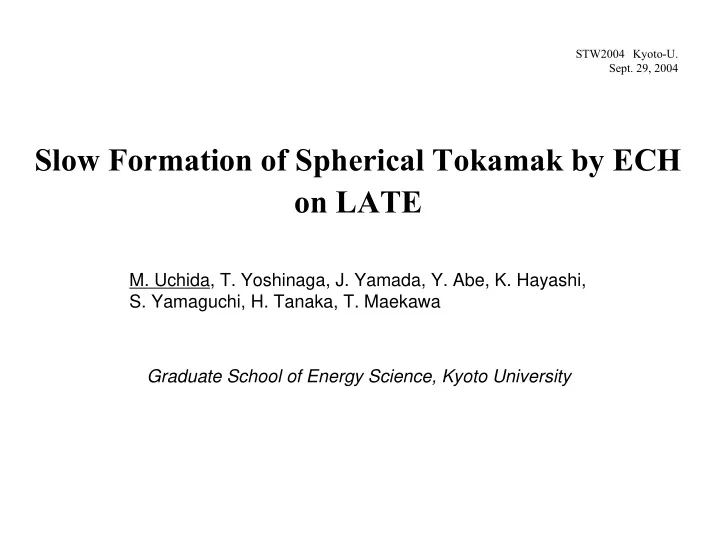

STW2004 Kyoto-U. Sept. 29, 2004 Slow Formation of Spherical Tokamak by ECH on LATE M. Uchida, T. Yoshinaga, J. Yamada, Y. Abe, K. Hayashi, S. Yamaguchi, H. Tanaka, T. Maekawa Graduate School of Energy Science, Kyoto University
Introduction Objective Formation of Spherical Tokamak by ECH alone without the central OH solenoid. • Formation of ST without the central solenoid - The central structure of ST could be greatly simplified by removing the CS. • Formation of ST by ECH - requires only a simple launcher remote from the plasma surface. * Plasma current generation and formation of the closed flux surface under steady vertical field (Bv) - CDX-U : Pressure driven current (~1kA) was spontaneously generated with appropriate Bv strength and decay index. * Ramp up of Ip … ? • This presentation reports: - Formation of ST with a slow current ramp up by a slow ramp of Bv to keep the equilibrium of the plasma loop with 2.45GHz - 4s microwaves.
Low Aspect ratio Torus Experiment
Low Aspect ratio Torus Experiment
10kW Discharge (Ip = 3.2 kA) I T = 60 kAT Density increases when Ip reached around 3 kA. ( ne > 3 ncutoff)
Visible light plasma images (a) t = 0.48 s (b) t = 0.50 s (c) t = 0.75 s (just after injection of 5kW µ -wave I) (with µ -wave II < 0.2 kW) (Ip = 1.2 kA) (d) t = 4.35 s (Ip = 3.2 kA)
Time evolution of poloidal flux contours and SXCT image n e ~ 3 n cutoff
EBW Heating? • The averaged electron density reaches 3 times the plasma cutoff density. • Second harmonic heating. → EBWs have very short wavelength (~ electron Larmor radius) and are supposed to be strongly absorbed even in the case of the second harmonic resonance in low temperature plasma. • Mode conversion rate? • η ~ 50 % if we assume a slab geometry. - note that experimental conditions significantly differ from slab geometry. (plasma radius ~ 20cm, wavelength = 12cm)
Time Evolution of Impurity Line and HX Radiation Impurity line radiations at higher excitation energies appear when Ip ~ 3 kA and ne increases. Hard X-ray radiation increases rapidly.
HX Spectra * Hard X-ray radiation appears when Ip exceeds about 2 kA. * The energy of hard X-ray radiation increases as Ip increases.
Hot Spot • Hot Spot appears on one edge side of an obstacle (launcher) inserted radially from the outboard side when the plasma current reaches ~ 3 kA and HX appears. • The glowing side is just that high-energy electrons flowing in the current carrying direction would hit on. => A unidirectional electron tail is developed during the discharge.
What is the mechanism of current drive ? • Development of unidirectional high energy tail → CD by EBW? • Contribution from the pressure driven current cannot be excluded due to the lack of information on the plasma pressure profile.
Ip increases with decreasing the Bv decay Index Plasma elongation and the cross section of the last closed flux surface become larger, and the plasma current increases. P inj = 10kW
The plasma current becomes higher with an additional heating power, but the plasma becomes vertically unstable as decay index decreases further P inj = 30kW (total) Ip reaches the higher current by increasing the microwave power. But plasma moves vertically.
Recent result: Ip = 6.25 kA, 20kW + 5kW + 5kW, n = 0.02, with active control of vertical plasma position
The attainable plasma current increases with RF power and vertical elongation 3 Magnetrons Low decay index with vertical plasma position control 2 Magnetrons Low decay index High decay index (n: decay index at R = 27.4 cm)
Magnetic field line on the last closed flux surface reveals the characteristic of ST equilibria Ip / It = 6.25 kA / 60 kAT = 10.4 % ( qa = 37, R/a~1.4, κ ~1.5 ) cf : WT-3 RF Tokamak : Ip / It = 20kA / 4900kA = 0.41 % JT-60U Startup without the CS coil : Ip / It = 600kA / 66000kAT = 0.91%
Summary • By injecting a 2.45 GHz microwave pulse up to 30 kW for 4 seconds, a plasma current has been initiated and ramped up over Ip = 6 kA by a slow ramp of the external vertical field to keep the higher plasma current in equilibrium. • Ip increases with increase of microwave power and Bv strength, and also with decrease of the Bv decay index to enlarge κ under active control of the vertical plasma position. • Magnetic analysis shows that a Spherical Tokamak equilibrium, having the last closed flux surface with an aspect ratio of R 0 /a = 21 cm/15 cm ~ 1.4 and an elongation of κ ~ 1.5 has been produced and maintained. • The soft X-ray CT image of the plasma cross section and the visible light plasma image coincide with the magnetic analysis. • Rj ~ R ( ω rf = 2 Ω ce) => suggesting EBW Heating • ne > 3 ncutoff • A unidirectional high energy electron tail is produced and developed during the discharge. => CD by EBW? • Contribution of pressure driven current is not excluded due to lack of information.
Recommend
More recommend